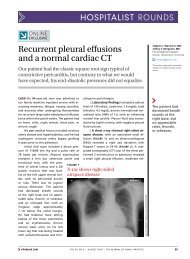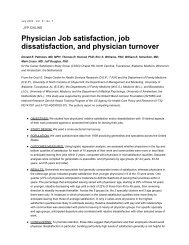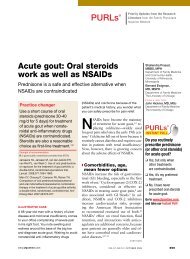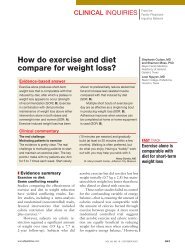Clinical Inquiries - The Journal of Family Practice
Clinical Inquiries - The Journal of Family Practice
Clinical Inquiries - The Journal of Family Practice
Create successful ePaper yourself
Turn your PDF publications into a flip-book with our unique Google optimized e-Paper software.
groups and geographic regions, and it has<br />
decreased dramatically in the last several<br />
decades. Racial and ethnic minorities and children<br />
<strong>of</strong> families with low incomes, who live in the<br />
Northeast or Midwest, or who live in older houses<br />
continue to be at increased risk. 1 Children with<br />
blood lead levels ≥10 µg/dL have been shown to<br />
have poorer cognitive and behavioral functioning. 2<br />
No studies have demonstrated that screening<br />
for lead poisoning improves outcomes. To justify<br />
screening, one must therefore extrapolate from<br />
indirect evidence, demonstrating that screening<br />
tests are accurate and that treatment <strong>of</strong> children<br />
detected by screening is effective. Capillary blood<br />
samples are comparable with venous samples for<br />
detecting elevated blood lead levels. <strong>The</strong> sensitivity<br />
<strong>of</strong> capillary samples ranges from 86% to 96%<br />
compared with venous samples. 3<br />
In low-prevalence areas, questionnaires may<br />
inform screening decisions. A questionnaire<br />
inquiring about age <strong>of</strong> housing, presence <strong>of</strong> peeling<br />
paint, ongoing renovations, siblings or playmates<br />
with elevated blood lead levels, adults in<br />
the home with occupational exposures to lead,<br />
and proximity to industrial sources <strong>of</strong> lead has a<br />
sensitivity for detecting blood lead levels ≥10<br />
µg/dL ranging from 32% to 87%. Sensitivity<br />
varies depending on the population and geographic<br />
location in which the questionnaire is tested.<br />
Accuracy is improved by tailoring the questionnaire<br />
based on locally important risk factors. 4<br />
Proposed treatments for elevated blood lead<br />
levels include chelation therapy, education about<br />
hygiene and nutrition, household dust control<br />
measures, and soil lead abatement. No goodquality<br />
trials have demonstrated that lowering<br />
slightly to moderately elevated blood lead levels<br />
(10–55 µg/dL) improves patient-oriented outcomes<br />
such as cognitive and behavioral functioning.<br />
Although 1 observational study <strong>of</strong> chelation<br />
therapy linked lowering blood lead levels with<br />
improved cognitive function, 3 a randomized<br />
controlled trial showed that chelation had no<br />
effect on cognitive or behavioral outcomes. 5<br />
All other trials evaluating treatment for lead<br />
CLINICAL INQUIRIES<br />
Because lead poisoning rates vary<br />
so widely, standard guidelines for<br />
screening are not possible<br />
poisoning looked at the intermediate outcome <strong>of</strong><br />
blood lead levels. A systematic review <strong>of</strong> randomized<br />
controlled trials showed that home dust<br />
control interventions reduced the proportion <strong>of</strong><br />
children with elevated blood lead levels (≥15<br />
µg/dL) from 14% to 6%. 6 A randomized controlled<br />
trial <strong>of</strong> high-efficiency particulate air (HEPA)<br />
filtration vacuuming showed no effect. 7 More<br />
intensive interventions such as soil lead abatement<br />
and paint remediation have not proven effective<br />
in good-quality randomized controlled trials.<br />
Increasing dietary calcium and iron and<br />
decreasing dietary fat are also commonly recommended<br />
for children with elevated blood lead levels,<br />
based on animal models and cross-sectional<br />
studies. <strong>The</strong> only randomized controlled trial that<br />
investigated calcium supplementation showed no<br />
effect on blood lead levels. 8 Our search revealed<br />
no good-quality studies on the effect <strong>of</strong> iron or fat<br />
intake on lead poisoning.<br />
In summary, because the prevalence <strong>of</strong> lead<br />
poisoning varies between communities and continues<br />
to change, standard recommendations are<br />
not possible. Clinicians must rely on local epidemiologic<br />
data to make screening decisions.<br />
Although questionnaires are accurate in predicting<br />
elevated blood lead levels in some settings, no<br />
specific set <strong>of</strong> questions can be recommended for<br />
all populations.<br />
No treatment options for those with mild to<br />
moderate elevations in blood lead levels have been<br />
shown to improve clinically important outcomes,<br />
although some interventions may decrease blood<br />
lead levels.<br />
■ RECOMMENDATIONS FROM OTHERS<br />
<strong>The</strong> Centers for Disease Control and Prevention<br />
(CDC) recommends<br />
• that individual states develop screening plans<br />
based on local data<br />
CONTINUED<br />
SEPTEMBER 2003 / VOL 52, NO 9 · <strong>The</strong> <strong>Journal</strong> <strong>of</strong> <strong>Family</strong> <strong>Practice</strong> 723








